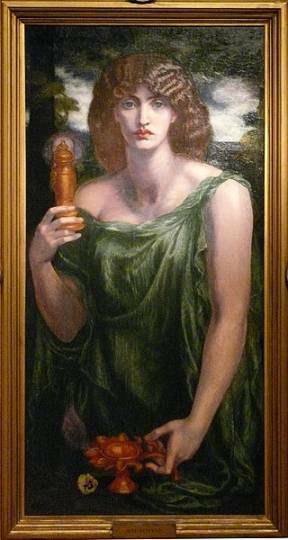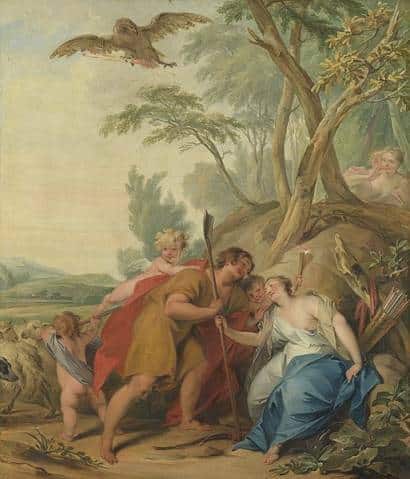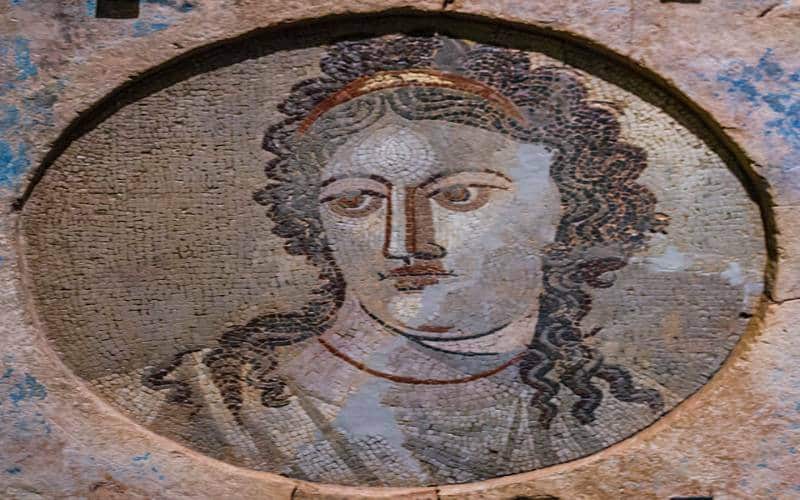Mnemosyne, the Greek goddess of memory, was considered one of the most powerful goddesses of her time. After all, it is memory, some believed, that is a gift that distinguishes us from the other creatures in the animal world. It is the gift that allows us to reason, predict and anticipate outcomes, and it is the very foundation for civilization.
Sadly, the goddess Mnemosyne is largely forgotten, lost in the mists of time. When she is remembered, it is usually only in the context of her being the mother of the Muses. However, all acknowledge that without memory, the lively arts of the Muses would never have been possible.
The Origin of Mnemosyne

Mnemosyne was a Titaness, a daughter of the first generation of deities in Greece. Her parents were the rulers Cronus and the goddess Gaia. Goddess Gaia, the Earth, married the god of the sky, Uranus, and they produced three sets of children: the Titans, the Cyclops, and the Hecatoncheires.
The War of Gods
Uranus loathed the monstrous Cyclops and Hecatoncheires and feared being overthrown by the Titans. He banished all his children to Tartarus, or the Underworld, causing Gaia great pain.
Gaia came to her children’s rescue. She created flint and made a scythe from it, urging her children to raise this weapon against their father. Cronus, the youngest of the Titan brothers, was the only one of her children to agree to use the scythe. He castrated Uranus with it, forever separating the Sky and the Earth. All the children of Uranus and Gaia were freed from Tartarus.
The liberation of the Titans by Cronus started the Golden Age, a time of prosperity for gods and men alike. However, Cronus feared having the same destiny as his father, being dethroned by his own son.
That’s why he swallowed each one of his children born by Rhea, his wife. However, Rhea and Gaia managed to hide their youngest son, Zeus, in the cave. Once Zeus grew up, he led a rebellion against his father.
Zeus was successful, and he banished his father and his supporters into the pit of Tartarus. One of Cronus’ supporters was Mnemosyne, but she was the only one that wasn’t banished.
The first reason for that was that Mnemosyne was never actively involved in ruling the world with other Titans. The second reason was that Mnemosyne was a lover of Zeus and, eventually, the mother of his daughters.
The Mother of The Muses
Once an important goddess in her own right, Mnemosyne is largely remembered today in her capacity as the mother of the Muses, the nine Greek goddesses whose role it was to inspire poets and musicians and to promote the arts and sciences.
After Zeus led the war against the Titans and established himself as the leader of the Olympians, he feared that, even though he might be immortal, his great victories and decisions might soon be forgotten.
Longing for a way to preserve the memory of his many great feats, he dressed as a shepherd and went to find Mnemosyne. They slept together for nine nights before he returned to his home on Mount Olympus.
Zeus got his wish. Months later, Mnemosyne gave birth for nine days, each day delivering a daughter. Collectively they were known as the Muses and were described as “having one mind, their hearts set upon song and their spirit free from care.”
No banquet on Mount Olympus was complete without them. Seated near the throne of their father, they entertained the guests, singing not only about the greatness of Zeus but about the marvelous feats of the Greek heroes and the creation of the heavens and the earth and all its wondrous creatures.
The importance of Memory
The goddess Mnemosyne is sometimes credited with being the first philosopher, her gift of the power of reason. She was responsible for naming all objects and, by doing so, gave humans the means to dialog and converse with each other. The powers to place things in memory and of remembrance were also attributed to this goddess.
Make no mistake about this. Memory was of the utmost importance at the time of Mnemosyne. Long before the invention of the alphabet and the written word, it was critical to the well-being of an individual or a society who had to rely solely on the lessons passed on in oral history.
Besides, we’re not talking about memorizing shopping lists or timetables here. The memory of Mnemosyne was much more than that. It was the memory of the rules and energies of the universe, the cycle of life, and the memory of how to live in the world.
Memory in the Afterlife
The ancients believed that when one died and crossed into the Underworld, one would be given a choice: whether to drink from the river Lethe where you would forget all the pains and terrors of your previous life (and with them, the lessons they brought), or whether to drink from the Mnemosyne, the spring of memory.
Those who chose to forget had to be reborn, to return to earth to learn the lessons they needed. Those who had chosen to remember were admitted to the Elysian Fields, where they would spend eternity in comfort and peace.
Oracle Initiation
The esteem in which the memory was held was made clear in the initiation rites of the ancient gnostics, who were required to consult with an oracle.
Before being brought to the oracle, initiates were taken to a place with two pools lying next to each other. They were instructed to first drink from the pool of Lethe, the goddess of forgetfulness. That was in order that they might forget their previous lives. Then they were taken to the spring of Mnemosyne to drink. Only this way would they remember all that they were about to learn from the oracle.
The initiate would then be ‘buried alive’ (i.e., placed in seclusion) for a few days . This was done in the ‘tomb’ of the earth god, Trophonios, to await the arrival of the oracle. If the initiate had been properly prepared and was found worthy, the mysteries of life would be told to him by the oracle.
When he was brought back into the realm of the living, the priests would set him upon a special seat called the Throne of Mnemosyne. While seated there, he would remember and tell all that he had learned below.
Legacy

Mnemosyne is usually depicted with a full mane of luscious hair, often a rich auburn in color. There are few stories about her, even though she is often mentioned by the ancient poets who recount her awesome gifts to mankind.
Mnemosyne was a personification of both individual and collective memory. She was often considered the source of language and writing but mainly of memorization. This was the foundation of the early Greek oral tradition. She stood apart from all the other Titans and was worshipped long after they were forgotten. Likely she was considered worth because of her exceptional role in managing memory.
The name Mnemosyne is related to the ancient Greek noun mneme meaning “memory,” and the verb “mimnesko”, to remember. This etymology is probably connected to the Indo-European word “mneh,” to mention, and “men” – remember . Therefore, the English word “memory” can be traced back to the same route.
Mnemosyne got transformed into the deity Moneta in Roman mythology. Interestingly enough, this makes the words “memory” and “money” related to each other.
Mnemosyne Symbols
Fountains, springs, and rivers were symbols of Mnemosyne. The springs, or fountains, of Lethe (oblivion) and Mnemosyne (memory), were the key part of the cult of Mnemosyne in Livadeia Boeotia.
However, other fountains featured in her story were real rather than mythical. There were numerous ones dedicated to Mnemosyne and the Muses in ancient Greece and Rome. It was thought that fountains dedicated to the Muses brought inspiration to poets, while their mother, Mnemosyne, was often regarded as the first Muse.
General
Apart from being symbolized by springs and fountains, Mnemosyne was often depicted as carrying a lamp of knowledge. Lamps and lightbulbs have symbolized knowledge, wisdom, and new ideas since the dawn of human civilization, and all knowledge would be lost if there was no Mnemosyne and memory.
Her other symbols are the number 9 and money.
Animals
In Greek mythology, Mnemosyne wasn’t given an animal symbol, but she can be symbolized by animals that are associated with memory and wisdom. With that in mind, elephants would be great symbols for Mnemosyne as they are well-known for their good memory.
Other animals that can be great symbols of Mnemosyne are the hawk, otter, and koala.
Plants
Forget-me-not is a wildflower with a specific name that makes it a perfect symbol for Mnemosyne, the goddess of memory. Other plants that can be used as Mnemosyne symbols are Ginkgo Biloba, myrtle, and periwinkle flower.
Perfumes/Scents
Rosemary, peppermint, citrus, cinnamon, jasmine, and chamomile are scents that are believed to improve memory, which makes them great symbols for Mnemosyne.
Gems and Metals
Jade is a gemstone that represents remembrance, and as such, it is a good symbol for Mnemosyne. Other gemstones that are believed to represent a memory or help you improve your memory are amber, turquoise, fluorite, and gold.
Goddess Jewelry
There are many reasons why you might want to keep a healing crystal or stone close to you. Getting closer to your goddess by wearing her color or crystal is a great one. That they also look great as jewelry only makes it so much better!
Here is a guide to crystal jewelry you hopefully will find helpful. In it is a list of 30+ crystals and links to some really great looking jewelry with that crystal or stone. Enjoy!
Colors
Psychologists have determined that red helps remember things, so this color is a great choice for the Mnemosyne symbol. Yellow has similar attributes, so it can also be used as a symbol of Mnemosyne.
Additionally, blue, white, and black can also be Mnemosyne’s symbols.
Embracing the Call of Mnemosyne: Recognizing Her Presence and Cultivating a Sacred Connection
Have you ever felt a deep connection to memories and knowledge, sensing that it might be more than just coincidence? For many spiritual seekers, the goddess Mnemosyne may be extending an invitation to connect. Explore how to recognize the signs of her calling, invoke her presence, and cultivate a meaningful relationship with this powerful Greek goddess.
How to know if Mnemosyne is calling you
One way to recognize Mnemosyne’s call is through powerful memories. Vivid recollections or déjà vu moments may be signs. Keep an eye out for any patterns in your memories, as Mnemosyne often communicates through them.
Dreams and visions are another way Mnemosyne may reach out. Dreams featuring her or her symbols, like the ancient scroll or quill, can be significant. Similarly, visions of libraries or other places of knowledge might signal her presence.
Finally, pay attention to synchronicities in your life. Repeated encounters with her symbols, or a strong attraction to her stories and mythology, can indicate that Mnemosyne is calling you. These patterns may seem coincidental, but they’re worth noting.
Invoking Mnemosyne
To call upon Mnemosyne, start by selecting a quiet location or creating an indoor space inspired by knowledge and memory. Incorporate her symbols, such as the ancient scroll, quill, or images of her into your chosen area. This will help establish a connection with the goddess.
During your ritual, light candles, particularly gold or white, as they represent wisdom and illumination. Offer symbols of Mnemosyne, such as books, writings, or even written intentions. These offerings demonstrate your dedication and respect for her.
In meditation, focus on your breath and clear your mind. Visualize Mnemosyne, her symbols, and the energy she embodies. Quietly ask for her guidance, and be open to any insights that may arise during your meditation.
Signs that Mnemosyne is present
Recognizing when Mnemosyne is with you is essential to deepening your connection with her. The goddess often manifests her presence in various ways, from emotional sensations to visual cues. Here are six signs to help you identify when Mnemosyne is near:
- Emotional sensations: Feelings of clarity, inspiration, or deep understanding can indicate her presence.
- Physical reactions: Sudden warmth, tingling sensations, or goosebumps may signal she’s near.
- Visual cues: Flashes of gold light, visions of scrolls or books, or glimpses of her symbols can be signs.
- Auditory cues: Hearing whispers, pages turning, or soft music may suggest her presence.
- Memory occurrences: Vivid recollections, déjà vu moments, or powerful dreams can be a signal.
- Intuitive connection: A strong sense that Mnemosyne is with you, even if you can’t pinpoint why, can be a sign of her presence.
Cultivating a relationship with Mnemosyne
To build a deeper connection with Mnemosyne, establish a consistent practice of meditation, prayer, or ritual to honor her. Make regular offerings, such as during moments of introspection or learning, to demonstrate your commitment to the goddess.
Embrace her values by fostering curiosity and the pursuit of knowledge in your life. Protect and nurture wisdom and learning, as these aspects are central to her being. Aligning your life with her principles will help deepen your connection to her.
Lastly, study her mythology and history. Read about Mnemosyne and her place in Greek mythology, and engage with others who share your interest. By exchanging insights and experiences, you’ll develop a richer understanding of the goddess and strengthen your bond with her.
Other Goddesses
If you enjoyed this post we are sure you will enjoy getting to know some of the other goddesses we also write about. You can find the complete list of goddesses sorted across regions and religions here.
Featured Image Credit: National Archaeological Museum of Tarragona, CC0, via Wikimedia Commons


